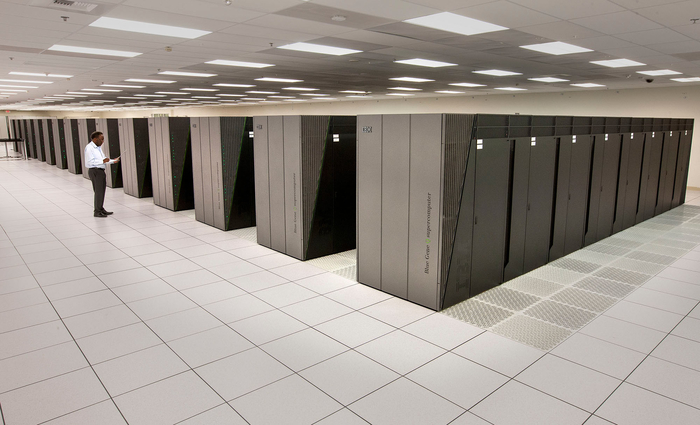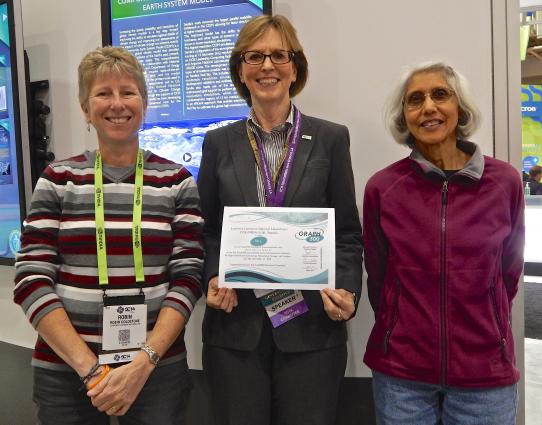Lawrence Livermore tops Graph 500
 (Download Image)
Lawrence Livermore's Sequoia ranked No. 1 on the Graph 500 list for using new techniques to solve large complex national security problems.
(Download Image)
Lawrence Livermore's Sequoia ranked No. 1 on the Graph 500 list for using new techniques to solve large complex national security problems.
New Orleans, Louisiana. Nov. 18, 2014 -- Lawrence Livermore National Laboratory scientists’ search for new ways to solve large complex national security problems led to the top ranking on Graph 500 and new techniques for solving large graph problems on small high performance computing (HPC) systems, all the way down to a single server.
"To fulfill our missions in national security and basic science, we explore different ways to solve large, complex problems, most of which include the need to advance data analytics," said Dona Crawford, associate director for Computation at Lawrence Livermore. "These Graph 500 achievements are a product of that work performed in collaboration with our industry partners. Furthermore, these innovations are likely to benefit the larger scientific computing community."
Lawrence Livermore’s Sequoia supercomputer, a 20-petaflop IBM Blue Gene/Q system, achieved the world’s best performance on the Graph 500 data analytics benchmark, announced Tuesday at SC14. LLNL and IBM computer scientists attained the No. 1 ranking by completing the largest problem scale ever attempted -- scale 41 -- with a performance of 23.751 teraTEPS (trillions of traversed edges per second). The team employed a technique developed by IBM.
The Graph 500 offers performance metrics for data intensive computing or ‘big data,’ an area of growing importance to the high performance computing (HPC) community.
In addition to achieving the top Graph 500 ranking, Lawrence Livermore computer scientists also have demonstrated scalable Graph 500 performance on small clusters and even a single node. To achieve these results, Livermore computational researchers have combined innovative research in graph algorithms and data-intensive runtime systems.
Robin Goldstone, a member of LLNL’s HPC Advanced Technologies Office said: "These are really exciting results that highlight our approach of leveraging HPC to solve challenging large-scale data science problems."
The results achieved demonstrate, at two different scales, the ability to solve very large graph problems on modest sized computing platforms by integrating flash storage into the memory hierarchy of these systems. Enabling technologies were provided through collaborations with Cray, Intel, Saratoga Speed and Mellanox.
A scale 40-graph problem, containing 17.6 trillion edges, was solved on 300 nodes of LLNL’s Catalyst cluster. Catalyst, designed in partnership with Intel and Cray, augments a standard HPC architecture with additional capabilities targeted at data intensive computing. Each Catalyst computer node features 128 gigabytes (GB) of dynamic random access memory (DRAM) plus an additional 800 GB of high performance flash storage and uses the LLNL DI-MMAP runtime that integrates flash into the memory hierarchy. With the HavoqGT graph traversal framework, Catalyst was able to store and process the 217 TB scale 40 graph, a feat that is otherwise only achievable on the world’s largest supercomputers. The Catalyst run was No. 4 in size on the list.
DI-MMAP and HavoqGT also were used to solve a smaller, but equally impressive, scale 37-graph problem on a single server with 50 TB of network-attached flash storage. The server, equipped with four Intel E7-4870 v2 processors and 2 TB of DRAM, was connected to two Altamont XP all-flash arrays from Saratoga Speed Inc., over a high bandwidth Mellanox FDR Infiniband interconnect. The other scale 37 entries on the Graph 500 list required clusters of 1,024 nodes or larger to process the 2.2 trillion edges.
"Our approach really lowers the barrier of entry for people trying to solve very large graph problems," said Roger Pearce, a researcher in LLNL’s Center for Applied Scientific Computing (CASC).
"These results collectively demonstrate LLNL's preeminence as a full service data intensive HPC shop, from single server to data intensive cluster to world class supercomputer," said Maya Gokhale, LLNL principal investigator for data-centric computing architectures.
Contact
Don Johnston[email protected]
925-784-3980
Related Links
Graph 500SC14
Sequoia retains top ranking on Graph 500 for third year running
Sequoia tops Graph 500 list of 'big data' supercomputers
Tags
HPC, Simulation, and Data ScienceHPC
Supercomputer
Computing
HPC Innovation Center
Science
Featured Articles








